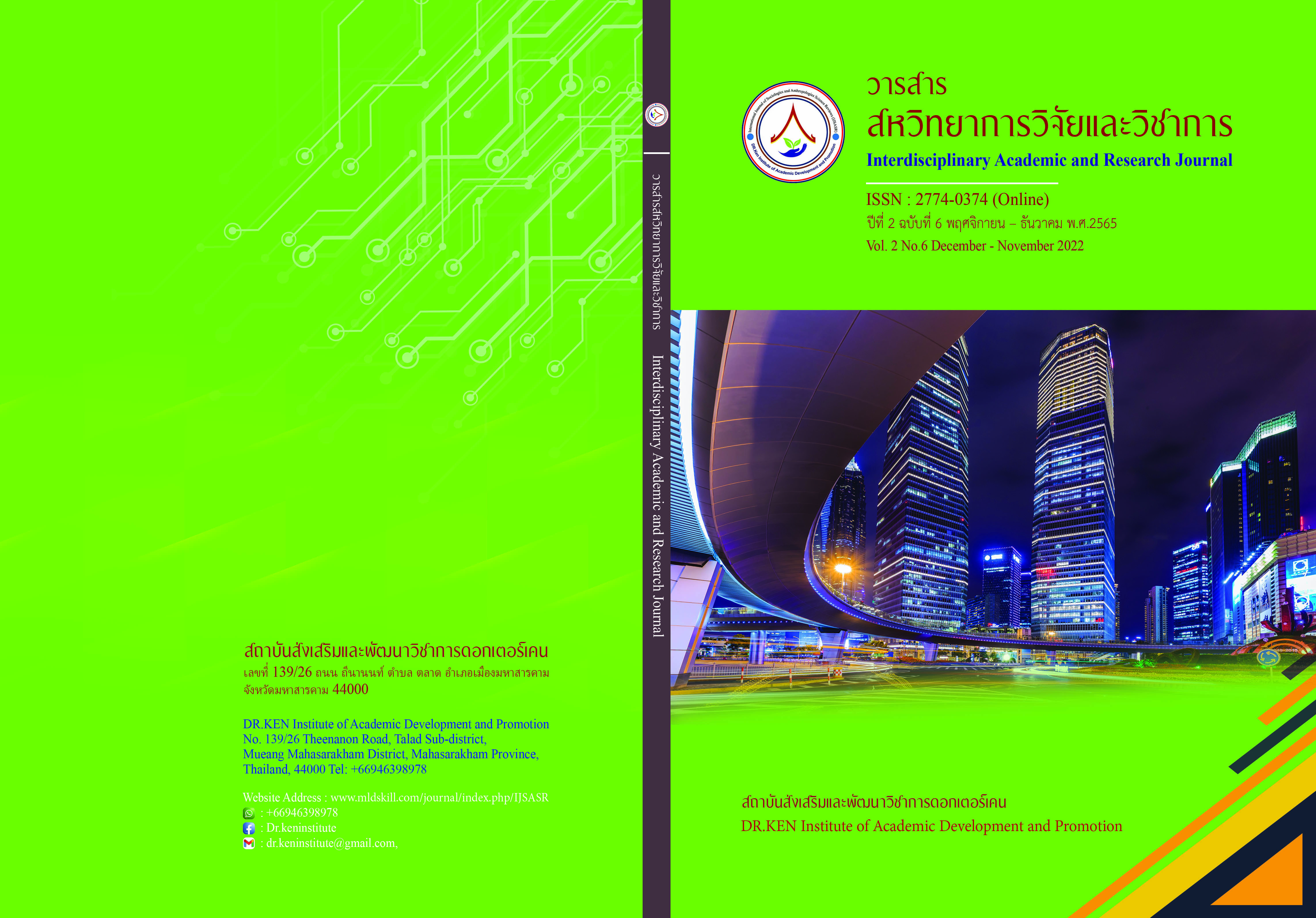The Model Development for Promoting the Elderly’s Quality of Life in the Northeast Area
DOI:
https://doi.org/10.14456/iarj.2022.160Keywords:
Quality of life Development; , Elderly; , Northeastern RegionAbstract
Situations of specific elderly people in Thailand that require special consideration, such as dependent, abandoned, homeless, ineligible or having personal status problems, reverse migration, and gender diversity. Thus, this research used a research methodology combining quantitative and qualitative methods. The objectives of this research were (1) to study the quality of life of the elderly in the northeastern region, (2) to study factors affecting the quality of life of the elderly in the northeastern region, and (3) to establish and confirm the model. Promoting the quality of life of the elderly in the northeastern region The research method was divided into 3 phases: Phase 1: a study of the quality of life of the elderly in the northeastern region and the study of factors affecting the quality of life of the elderly in the northeastern region; The Model for Enhancing the Quality of Life of the Elderly in the Northeastern Region Phase 3 Confirmation of the Model for Enhancing the Quality of Life of the Elderly in the Northeastern Region The sample group and key informants used in the research were divided into 3 groups: 400 elderly people in the northeastern region, using a stratified random sampling method. and simple random sampling: 10 experts working with the elderly, and 5 experts on the elderly were selected by purposive random sampling. The research tools were quantitative questionnaires. There was a confidence value of 0.996 for the whole paper. and a questionnaire confirming the quality-of-life promotion model of the elderly in the northeastern region. The results of the research were as follows: (1) the quality of life of the elderly in the northeastern region; was at the highest level, the environmental quality of life and psychological quality of life were at the highest level respectively, the physical quality of life was at a high level. (2) Factors affecting the quality of life of the elderly consisted of personal factors. family factor daily practice factors social support factor Life satisfaction factor and the factor of self-worth and the results of structural relationship model analysis of factors affecting the quality of life of the elderly in the northeastern region found that the chi-square value ( )=16.074, the degree of independence (df)=15. The level of statistical significance was close to 1 (p=0.377), x =1.072. which is less than 2.00, which means that the model is in good agreement with the empirical data. In addition, the harmonization index (GFI) = 0.992, the relative consistency index (NFI) = 0.996, the model acceptability index (TLI) = 0.999, which the acceptance level should be greater than 0.95 and, in the value, RMSEA = 0.013, RMR = 0.010, which is less than 0.05, is considered good. (3) Models for promoting the quality of life of the elderly are as follows; (A) Older people should always take care of their health and learn new things. (B) Sub-district health promotion hospitals should organize activities for the elderly to know how to take care of their health at all times and provide facilities for medicines for the elderly with underlying diseases. (C) Local government organizations should organize training programs for vocational promotion for the elderly and provide distribution centers for the elderly. (D) Government agencies should increase the allowance for the elderly to be sufficient for their monthly living and promote old Thai values that value the elderly, such as respect for adults. (E) The sub-district cultural council should organize activities according to the traditions of each area for the new generation to pay attention and give importance to their arts and culture and return to their hometowns and take care of the elderly who are waiting at Home from time to time. And (F) The community should do activities to repair homes for elderly people who are in unfavorable conditions to live in. It is an opportunity for the elderly to express their feelings and show their ability to accept that the elderly are experienced people.
References
จิรัชยา เคล้าดี และคณะ. (2560). ปัจจัยที่มีผลต่อคุณภาพชีวิตของผู้สูงอายุในจังหวัดนครศรีธรรมราช. วิทยานิพนธ์ปริญญารัฐประศาสนศาสตรมหาบัณฑิต. กรุงเทพฯ: คณะรัฐศาสตร์และรัฐประศาสนศาสตร์ สถาบันรัชต์ภาคย์.
ปฐมพงศ์ เปรินทร์. (2561). กลยุทธ์การพัฒนาคุณภาพชีวิตของผู้สูงอายุภาคตะวันออกเฉียงเหนือ. วารสารวิทยาลัยนครราชสีมา. 12(1),179 – 191.
พงศ์รัตน์ ภิรมย์รัตน์,ฤๅเดช เกิดวิชัยและณัฐพงษ์ เตชะรัตนเสฏฐ์. (2563). รูปแบบการพัฒนาคุณภาพชีวิตของประชาชนจังหวัดแพร่. วารสารสันติศึกษาปริทรรศน์มจร. 8(4), 1492-1505.
พรสรรค์ ปิยนันทิศักดิ์. (2563). รูปแบบการส่งเสริมคุณภาพชีวิตของผู้สูงอายุโดยชุมชนในจังหวัดขอนแก่น. วารสารสถาบันวิจัยและพัฒนา มหาวิทยาลัยราชภัฏมหาสารคาม, 7 (2), 209-226.
เพียร เป็นพร้อม, วัชรินทร์ สุทธิศัย และสมเกียรติ เกียรติเจริญ. (2563). รูปแบบการพัฒนาคุณภาพชีวิตของผู้สูงอายุเชิงนโยบายสาธารณะกรณีศึกษาจังหวัดสุรินทร์. วารสารการเมืองการปกครอง. 10(3),139-154.
มูลนิธิสถาบันวิจัยและพัฒนาผู้สูงอายุ. (2565). รายงานสถานการณ์ผู้สูงอายุไทย พ.ศ. 2565. กรุงเทพฯ : มูลนิธิสถาบันวิจัยและพัฒนาผู้สูงอายุไทย.
มูลนิธิสถาบันวิจัยและพัฒนาผู้สูงอายุไทย. (2563). สถานการณ์ผู้สูงอายุไทย พ.ศ. 2563 = Situation of the Thai Elderly 2020/มูลนิธิสถาบันวิจัยและพัฒนาผู้สูงอายุไทย (มส.ผส.). กรุงเทพฯ : มูลนิธิสถาบันวิจัยและพัฒนาผู้สูงอายุไทย.
รังสรรค์ สิงหเลิศ. (2551). ระเบียบวิธีวิจัยทางสังคมศาสตร์. มหาสารคาม : มหาวิทยาลัยราชภัฏมหาสารคาม.
สำนักงานสถิติแห่งชาติ. (2564). สถิติผู้สูงอายุไทย พ.ศ. 2564. กรุงเทพฯ : สำนักงานสถิติแห่งชาติ.
โสภา ขันทะเสน, อรุณ รักธรรม, อุดมวิทย์ ไชยสกุลเกียรติ, และเพ็ญศรี ฉิรินัง. (2565). รูปแบบในการพัฒนาคุณภาพชีวิตผู้สูงอายุในกรุงเทพมหานคร โดยสถานศึกษาในสังกัดสำนักงานคณะกรรมการการอาชีวะศึกษา. วารสารวิชาการและวิจัย มหาวิทยาลัยภาคตะวันออกเฉียงเหนือ. 12(1), 58-72.
อภินันท์ สนน้อย, ปิยาภรณ์ ศิริภานุมาศ และ สุรชัย ปิยานุกูล. (2559). รูปแบบการพัฒนาคุณภาพชีวิตผู้สูงอายุ ในจังหวัดบุรีรัมย์. วารสารวิชาการมหาวิทยาลัยราชภัฏบุรีรัมย์. 8(2), 153-169.
Yamane, T., (1973). Statistics: An Introductory Analysis. 3rd Ed. New York: Harper and Row Publications.
Downloads
Published
How to Cite
Issue
Section
License
Copyright (c) 2022 Arthit Borihan , Yupaporn Yupass, Phakdee Phosing

This work is licensed under a Creative Commons Attribution-NonCommercial-NoDerivatives 4.0 International License.
Copyright on any article in the Interdisciplinary Academic and Research Journal is retained by the author(s) under the under the Creative Commons Attribution-NonCommercial-NoDerivatives 4.0 International License. Permission to use text, content, images, etc. of publication. Any user to read, download, copy, distribute, print, search, or link to the full texts of articles, crawl them for indexing, pass them as data to software, or use them for any other lawful purpose. But do not use it for commercial use or with the intent to benefit any business.
















.png)


